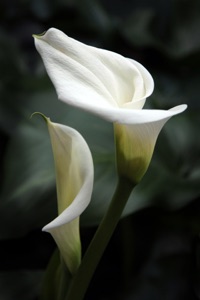Boringly Beautiful?

Sometimes stunningly beautiful subjects—like the lilies at the left—are SO beautiful they can be trite. Perhaps the suggestions below can help make pictures of beautiful subjects more interesting.

After a Trip to Longwood Gardens
Monday, January 31, 2011
For a visually-oriented person who also loves nature, a visit to our area’s famous Longwood Gardens (a former DuPont family estate) is a real treat. My wife and I went there this past weekend. I took the photo above on that visit.
As I was shooting pictures in the Conservatory, I recalled reading that after family members, the next most photographed subjects are flowers. But Debbie observed that it’s extremely difficult to take a picture of a showy flower in a way that is displays originality and fresh perspective.
As a case in point, in the downstairs lobby area of Longwood’s Conversancy is currently hanging an exhibit of 20 or 30 large (20” x 30” or so) prints of flowers presumably taken at Longwood. Each of these pictures were technically excellent, but we reflected that few of them engaged us any more than the usual picture in any gardening book.
Part of the reason why flowers are so often photographed, of course, is that they’re gorgeous and most modern cameras will permit the close-focusing that floral photography requires. In other words, it’s reasonably easy to get a lovely picture of a flower. But how do you capture anything like the loveliness, immediacy, and freshness of your own experience with a fetching bud?
Here are a few ideas, by no means the last word on the subject: we’re learning, too!
-
1.GET IN CLOSE. I watched as other people sought to capture the flowers at Longwood by trying to capture the entire panarama. This is a mistake. At a minimum, get up close and personal; fill the frame with the flower.
-
2.TURN OFF THE FLASH. Nothing makes anything uglier (in my humble opinion) that direct, frontal flash. Want to make a gorgeous flower seem ordinary and flat? Use flash. Turn it off!
-
3.TAKE AN UNCOMMON VIEW. Get on your knees. Point the camera skyward. Take a picture of just part of the flower.
-
4.BE WILLING TO USE ALL YOUR PHOTOSHOP TRICKS. Look at the photo of the lilies, above. In the original picture, only the lily on the right was in the frame. Would you think of me as a cheat if I told you that I added in the lily on the left? And how about the vignetting, the darkness around the perimeter of the picture? I added that in Photoshop, too, in order to minimize distractions and direct the viewer’s eye to the central subject. Is this cheating, too? My answer to both questions is “No.”
In visiting Longwood my goal was to bring back photographic material enough to make some nice pictures, not to engage in photojournalism, so it matters not at all to me that the picture doesn’t reflect “reality.” But is this picture of a beautiful subject interesting or boringly trite? I think it begins to move in the direction of interesting, but frankly, I’m not sure how close it comes. Sometimes beauty is the most challenging subject!
PS: I used a $1,000 Canon lens to get my shots that day. My wife was using a lens we bought used from eBay for $200, a Canon 28-135mm macro lens. Guess who got the better shots?! Way to go, Deb!

